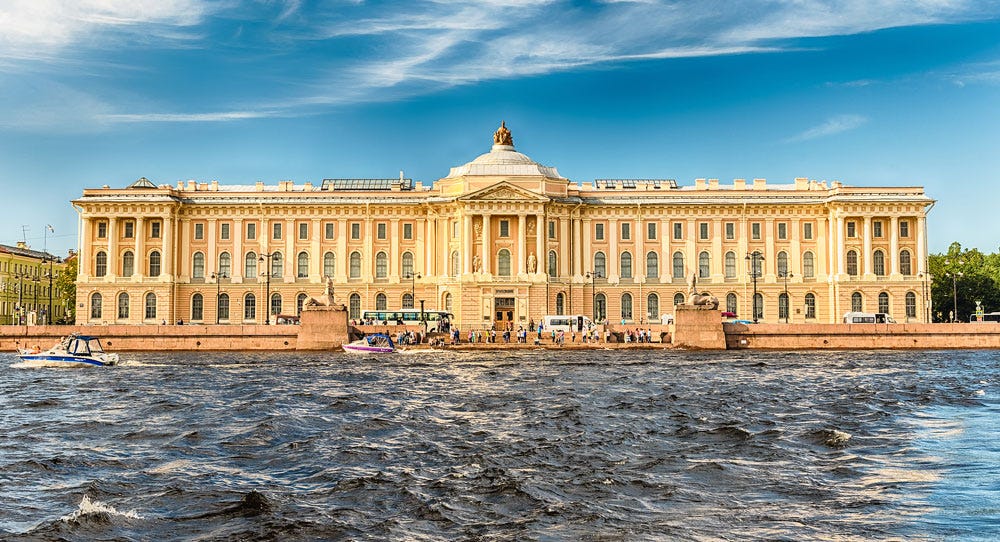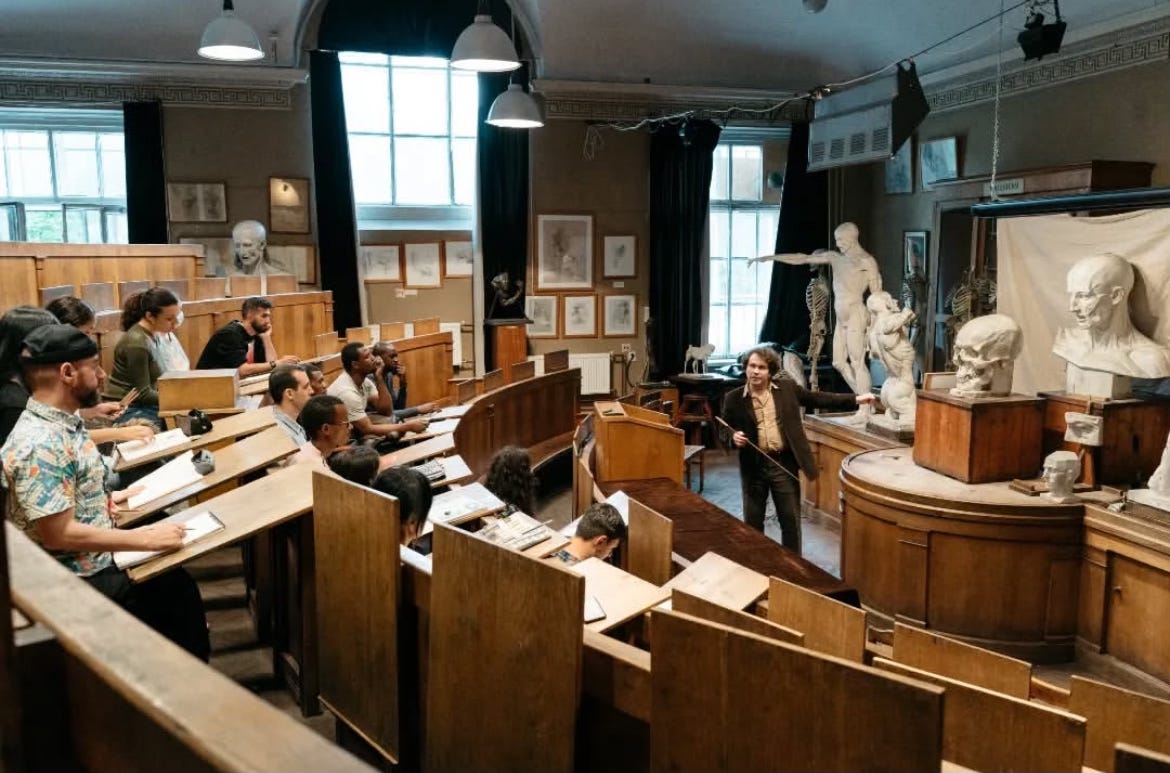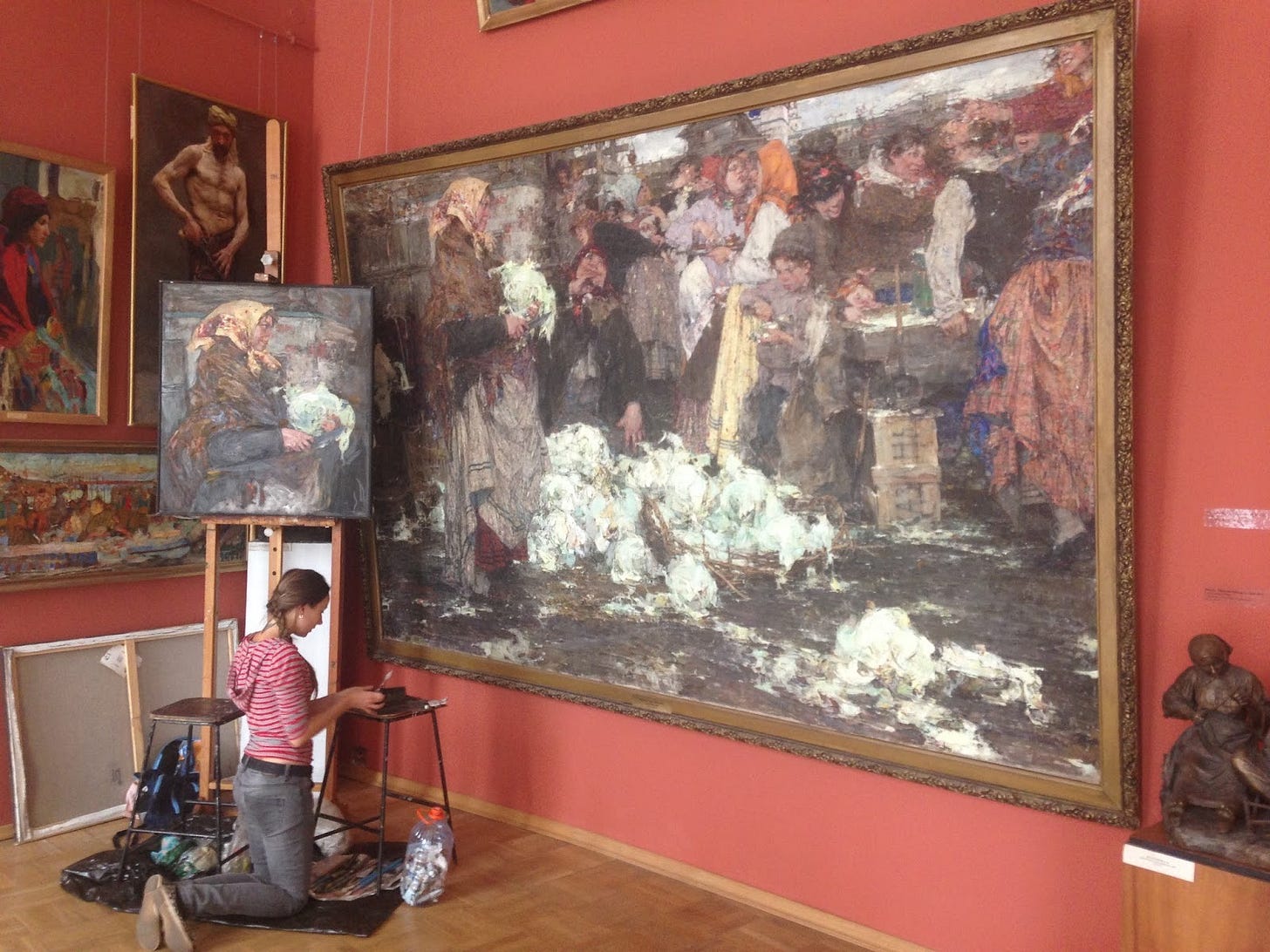the future of classical art
a deep dive on the best art school in the world: the Imperial Academy of Arts
In today’s world, contemporary art is highly celebrated for its speed, abstraction, and conceptual focus. However, there is still a school that teaches the traditional foundations of art—drawing from life, anatomical precision, and expressive brushwork. Nestled along the banks of the Neva River in St. Petersburg, Russia, the Imperial Academy of Arts continues to train artists in the demanding traditions of classical realism.
I first heard about the Academy when YouTube recommended Ksy Elf’s channel. In her videos, she shares her early days as a student at the Academy, showcasing the classrooms, historic buildings, and dedicated teachers. I immediately fell in love with the institution. It has that old academic aesthetic—with a focus entirely on art. If you have the time, I highly recommend watching her videos. Ksenia goes in depth about her school, her classes, and the art she creates.
I am going to go delve into on how the Russian Academy of Arts—formerly the Imperial Academy—rose to become one of the most respected art institutions in the world. With its deep roots in classical training and heavily focus on technical mastery, the Academy has shaped generations of artists and continues to influence how representational art is taught and valued today.
history
Peter the Great envisioned the creation of a Russian artistic school and in 1757, the Academy of Three Noble Arts—the noble arts being painting, sculpture, and architecture—was founded. It was established in St. Petersburg by Ivan Shuvalov, a noted Enlightener of that time, and under the patronage of Empress Elizabeth of Russia. Shuvalov invited teachers from Europe, recruited students to be trained at the Academy, and donated his private fine arts collection which became the foundation of the Academy’s museum and library.
In 1764, Catherine the Great emphasized the importance of the Academy by officially declaring it the Imperial Academy of Arts. This significantly expanded the Academy’s influence and resources, as it was now a state-sponsored institution. Catherine viewed the arts as essential to Russia’s cultural development.
That same year, French architect Jean-Baptiste Vallin de la Mothe and Russian architect Alexander Kokorinov began constructing of the Academy’s main building, located along the Neva River. The building was completed in 1788 and became a landmark of neoclassical architecture, symbolizing Russia’s growing engagement with Enlightenment ideals and European artistic traditions.
During the 18th and 19th centuries, the Academy reached its peak. Russian students began producing artwork that rivaled European standards. The Academy regularly sent students abroad—especially France and Italy—to study classical art firsthand. It also played a key role in expanding art education across the country by initiating the establishment of provincial art schools and colleges, offering them extensive support. In this Golden Age, the Academy produced many of Russia’s most celebrated artists, including Karl Bryullov, Ilya Repin, and Ivan Aivazovsky.
Although the Academy remained a prestigious institution, it did not escape criticism and challenges. By the late 19th century, many artists felt the school was out of step with the times, resistant to modern artistic movements. While the Academy made efforts to revise its curriculum, it struggled to fully adapt to emerging styles such as Realism and Impressionism. After the Bolshevik Revolution in 1917, the Imperial Academy of Arts was officially abolished by Valdimir Lenin’s decree, though its educational structure remained largely intact.
Under Soviet rule, the Academy was forced to align with state ideology, producing art that glorified the Soviet state, the working class, and labor—the symbols of Socialist Realism. However, after the collapse of the USSR, the Academy was restructured again, returning to its foundations of technique, tradition, and classical training, ultimately reemerging as the Russian Academy of Arts.
why is it prestigious?
As I began researching the Academy after discovering Ksenia’s videos, I was drawn to what makes this school one of the best in the world: it teaches the esoteric Russian academic method of drawing—an approach rarely found elsewhere.
Today, most degree-granting universities and art institutes focus on modern and contemporary art, emphasizing individual expression, originality, and experimental forms. While students may still study representational art—drawing what they observe in nature—technical mastery is often secondary to conceptual exploration. Yet for many artists, especially those who admire the traditions of the Old Masters (highly skilled painters who worked in Europe before the 1800s), the desire to first master technique remains central to their artistic journey.
Those who want to follow traditional techniques often turn to non-degree art schools called ateliers. These schools typically teach using the sight-size method, which has students stand at a fixed distance from the subject and draw it to the same scale on their paper or canvas. This allows for accurate proportions through direct visual comparison and trains the eye to replicate shapes, values, and forms with precision.
The Russian academic method of drawing, on the other hand, takes a more constructive and intuitive approach. Instead of relying solely on visual measurement, students study human anatomy and learn to break down forms into basic shapes like spheres, cylinders, and cubes. This method draws inspiration from Michelangelo and Leonardo da Vinci, emphasizing structural understanding, light logic, and imaginative construction. The goal is not just to copy what you see, but to understand and rebuild the form from within, allowing the artist to draw realistically from imagination without relying on a reference.
the future of art
Learning about the Imperial Academy of Arts has made me reflect on the future of art and art education. Will schools continue to move further away from traditional styles and techniques? Will there still be students who seek out classical training and the old methods? Or will these teachings gradually fade as the art world grows increasingly modern and concept-driven?
While every artist expresses themselves in their own unique way, having a strong foundation in technique and form will always enhance the quality of their work. In most art classes, students do study the basic principles—such as shape, lighting, and perspective—and complete early drawing exercises to build understanding. However, there’s rarely enough time to truly refine these skills before moving on to other topics. Unlike students at the Academy, most artists don’t have the opportunity to spend years honing their technique with such focus and depth.
For almost three centuries, the institution has upheld its values of true artistic expression, grounded in discipline, observation, and a deep understanding of form. While many art schools have shifted toward postmodernism and conceptual approaches, the Academy continues to prioritize craft and technique above all.
What the Academy is doing earns my deepest respect. It preserves and passes down the time-honored teachings and techniques of renowned painters who have shaped the course of art history. You won’t find this level of depth and dedication at most universities, especially not over the span of several years. In many ways, the act of teaching this tradition is an art form in itself—and it is the Academy that ensures these practices are not lost to time.
sources:
https://eng.rah.ru/academy/history/
https://nyaa.edu/glory-days-russian-academy-of-st-petersburg/
thedavintagist. (2021). Studying the esoteric Russian academic method of drawing that has been quietly preserved in St. Petersburg for over 250 years. Reddit. https://www.reddit.com/r/DarkAcademia/comments/l3a1qf/studying_the_esoteric_russian_academic_method_of/
Ksy El’s YouTube channel: https://youtube.com/@ksyelf5820?si=usIInYM0UFzXNz9J









Ivan Aivazovsky is one of my favourites 👌.
Their technique of breaking down forms into shapes to later draw people from imagination is brilliant. No wonder they could render mythological or biblical stories so realistically.
Very interesting!